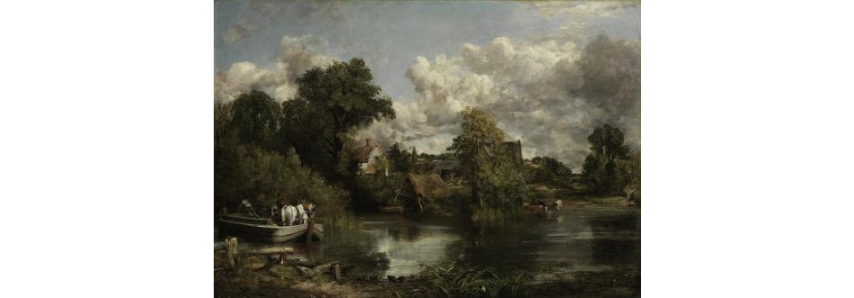The White Horse (previously called Scene on the River Stour)
The painting marked a vital turning point in Constable’s career and was the first in the series of ‘six-footers’ depicting scenes on the River Stour which also included The Haywain and was said to define his artistic maturity and secured his professional reputation.
- 57
- 1819
- 131.4cm x 188.3cm
- Frick
- Oil on Canvas
- 90
- Oil on Canvas, 1819, 131.4cm x 188.3cm, Frick
- Flatford
- Famous
- 51.957874, 1.021455
Details
This view of Willy Lott’s House clearly shows the farmhouse known as ‘Swan Nest House’ to the North East. This area has the remains of a moat and which creats an island known as Swan Nest. It is not known art what date ‘Swan Nest House’ dissapeared.
As Constable’s professional ambition increased, so did the size of his canvasses, and in 1825 he exhibited his series of six ‘six footers’ at The Royal Academy, titled ‘Landscapes’ and of which five of the six paintings were set around the River Stour at Flatford including this piece ‘The White Horse’ 1819, together with ‘The Haywain’ 1821, ‘view on the Stour near Dedham’ 1822, ‘The Lock’ 1824, ‘The Leaping Horse’ 1825, and the sixth being further up stream at Stratford (Stratford Mill 1820)
This painting marked a turning point in Constable’s career as, although the artist had sketched this scene twice before in preparation for this large piece, he only added the white horse to the scene in preparation for the 1819 Academy exhibition.
Originally known as ‘A scene on the river Stour’ it’s true size made it ‘too large to remain unnoticed’ and attracted more attention than anything Constable had exhibited before. John Fisher, Bishop of Salisbury, friend to the artist, bought the painting at the price asked by Constable, 100 guineas, the largest sum he had received so far for a picture.
It reached Salisbury in the April of 1820 and the Archdeacon wrote ‘hung on a level with the eye, the lower frame resting on the ogee: in a western side light, right for the light of the picture, opposite the fire place. It looks magnificently. My wife says she carries her eye from the picture to the garden & back observes the same sort of look in both’
Constable borrowed back the said piece for his exhibition of works by ‘Living Artists of the English School’ held at the British Institute in 1825, and by 1829 the artist bought back the painting from Fisher after the latter suffered financial difficulties.
Purchased by the Frick Collection 1943
- 57
- 1819
- 131.4cm x 188.3cm
- Frick
- Oil on Canvas
- 90
- Oil on Canvas, 1819, 131.4cm x 188.3cm, Frick
- Flatford
- Famous
- 51.957874, 1.021455

